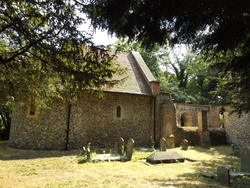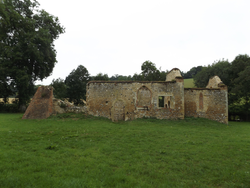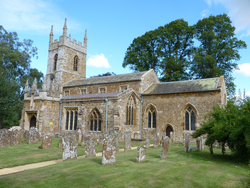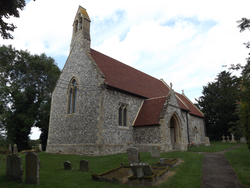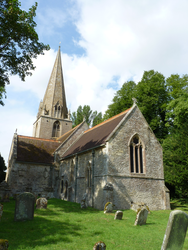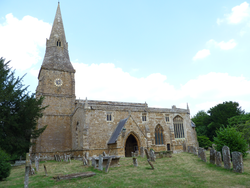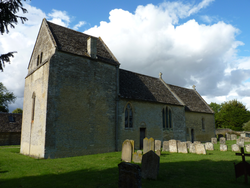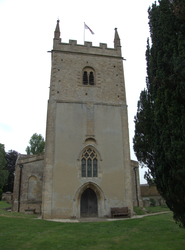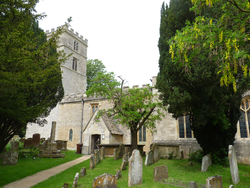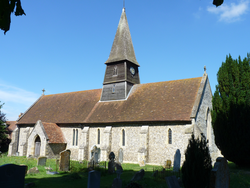
The Corpus of ROMANESQUE SCULPTURE in Britain & Ireland

Oxfordshire (pre-1974 traditional (England and Wales))
Ruined parish church
Mongewell is a small village in the parish of Crowmarsh Gifford on the east bank of the river Thames. The church, which is built of flint with stone dressings, consists of a nave, chancel and west tower. It dates from the 12thc and was remodelled in the picturesque Gothick style for Shute Barrington, Bishop of Durham, in 1791.The church was restored under the direction of Lewis Wyatt in 1880. The nave is now roofless and the church is in the care of the Churches Conservation Trust. Two12thc corbels have been reset on either side of the 19thc chancel arch.
Ruined parish church
Bix is a rural parish set in a typical Chilterns landscape of woodland and steep valleys, small road-side hamlets and isolated farms. The now ruined church of Bix Brand is a two-cell Romanesque structure with late medieval alterations and later rebuilding. The main structure is made from unknapped flints, with stone dressing and areas of brick and plaster.
Parish church
South Newington is a small village in the ironstone area of N Oxfordshire between Chipping Norton and Banbury. The early church probably existed in the mid-C12th, consisting of a chancel, nave and N aisle. There was a major remodelling c. 1300 that doubled it in size, adding the tower, S aisle, lengthening the nave, adding to the N aisle and adding a new chancel. The E bay of both aisles is of this date and wider than the others, indicating that the new chancel was extended further east. Clerestories were added in the C15th. St Peter’s is renowned for its high quality wall paintings. Remaining Romanesque features are two external buttresses, a N nave arcade of two bays with round arches and decorated capitals, and a font. There is also a sculpted head on the W respond of the N arcade, and some loose sculpture, that may be Romanesque.
Parish church
Britwell Salome is a small South Oxfordshire village about 4.5 miles NE of Wallingford. The church, which was rebuilt in 1867 by Charles Buckeridge, is of flint and stone construction. It consists of chancel, nave, vestry, S porch and western bellcote. Its predecessor had a Romanesque chancel arch and a S nave doorway of the same period. The latter was reused in the 1867 church.
Parish church
Broadwell is a village about nine miles W of Witney. The church lies to the N of the village and was built around 1190 of coursed rubble limestone (Sherwood and Pevsner (1974), 488-9). The church originally consisted of a chancel, a presbytery bay, a nave and a W tower. In the 13thc the whole building was remodelled: the chancel and the presbytery were united to form an enlarged chancel, new windows and buttresses were added to the chancel and tower, and the N and S chapels were built. The church was extensively restored in 1873 by Edward George Bruton. The surviving Romanesque features are the nave N and S doorways, the E tower arch and the Transitional, or possibly later, font located at the W end of the nave.
Parish church
St Mary's, Broughton, is in the north of the county, 4 km west of Banbury, situated in the parkland of Broughton Castle. The church is built of the local ironstone and comprises a chancel, nave, S aisle and a W tower with a broach spire. Both the church’s layout and characteristics, such as the almost identical width of the nave and the S aisle, suggest a possible remodeling of an earlier building, which took place c. 1300, with further changes made in the course of the century. The only Romanesque feature is the font decorated with a band of cable and chevron moulding.
Parish church
Broughton Poggs is a village about four miles SW of Carterton. The church lies to the S of the village and was built of coursed rubble limestone with dressed quoins. The 12thc chancel was extensively altered in the 13thc, whilst the nave and the massive W tower are original. the church was extensively restore and altered in 1874. Romanesque sculptural elements consist of the chancel arch, the N and S doorways, the windows in the nave and the W tower, two blocks decorated with chevrons reset into the tower arch, and the font.
Parish church
Spelsbury is a small village in the NW of Oxfordshire, 3 miles SE of Chipping Norton, on the oolitic limestone belt. Of the original Romanesque church, only the central tower survives, now at the W end. In the C13th the nave was rebuilt on the site of the previous chancel, and the transepts and aisles were probably added at this time. In the C14th the W door and a window above were added to the tower. The tower was restored in 1706, and the chancel rebuilt in 1740. In 1774, when the nave and aisles were remodelled, blind arched recesses in the classical style were added at the ends of the transepts and at the W ends of the nave aisles, giving the impression of a larger and grander church. The Romanesque two-stage tower has round-headed bell openings on all four sides, original flat pilasters, and on the W face, the arch of a round-headed window. Internally, the remodelled E tower arch retains its restored responds with billet and cushion capitals.
Parish church
Only five miles N of Oxford, Yarnton is outside the city in a quiet rural situation. St Bartholomew’s was originally a small Romanesque church of nave and chancel. It was expanded in the C13th by the addition of a four bay arcade. The present S aisle may represent the Romanesque nave, as its S wall preserves a plain late C12th doorway, and also two deeply splayed windows, now with C19th lights. The N wall of the chancel has a round-headed window, possibly reusing C12th stonework. In 1611 Sir Thomas Spencer had a spacious chapel built as a setting for the family monuments, E of the S aisle and alongside the chancel. The Romanesque font is now sited within it.
Parish church
Sydenham is located 3 miles SE of Thame in SE Oxfordshire. The church is a small building of flint and stone, with a wooden central tower with a broach-spire, dating mainly from the C13th and restored in the C19th. It boasts some Romanesque corbels in the chancel (Sherwood and Pevsner), but these are of wood and of doubtful date and so not included in this entry. However, there is a plain tub font, probably Romanesque.
